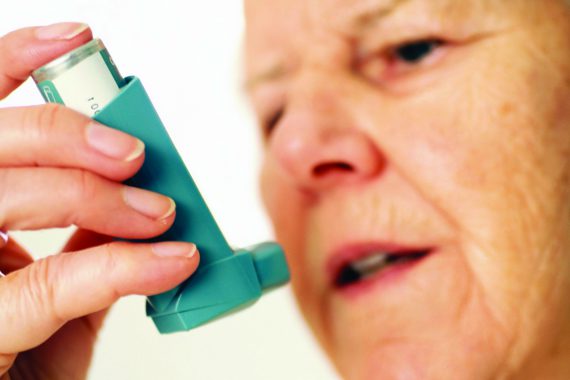People with asthma over the age of 55 years are the most likely age group in the UK adult population to experience ‘flare-ups’ of their symptoms, according to new research.
The study, presented today at the British Thoracic Society winter meeting, concluded that this may have important implications for how older patients are cared for and monitored.
Researchers from Imperial College and the London School of Hygiene and Tropical Medicine examined medical records of over 424,000 patients of all ages, with all types of asthma, covering an eight year period from 2007 to 2015 – a first in terms of scope and scale.
Of these, 60% of patients had a mild form of the condition and do not tend to experience ‘flare-ups’.
But patients over the age of 55 years were far less likely to have mild asthma than the younger group, and far more likely to experience symptom flare-ups despite taking their treatment. The opposite was found in patients aged between five and 18.
Children under five years old, if they had flare-ups, had the highest frequency per year.
In all age groups ‘flare-up’ rates increased with increasing asthma severity, and a number of other factors including gender, lower socioeconomic status, history of gastro-oesophageal reflux, atopy, anxiety, smoking or COPD.
Older patients were found to be more likely to have asthma alongside other conditions, with 23% of the over 55s also having a diagnosis of COPD.
The risk of a flare-up of symptoms was measured using the BTS/SIGN British Guideline on the Management of Asthma ‘stepwise’ approach.
Dr Chloe Bloom, lead researcher and respiratory clinical academic at Imperial College, said that asthma is highly prevalent in the UK but previously we had ‘little information about the UK’s general asthma population, as seen within primary care, with most publications instead focusing on patients seen in secondary care with more severe asthma.’
She added: ‘Around three-quarters of all asthma flare-ups were treated within primary care. The oldest age group, although were most likely to have a flare-up, were least likely to require over-night hospitalisation for their exacerbation, compared to the younger age groups.
‘The results perhaps suggest that we should increase our asthma care focus on the older age group. More research is needed to look at how this might impact in practice on primary care treatment of people with asthma. This could include having more regular check-ups with their GP.’
Dr Samantha Walker, director of research and policy at Asthma UK, said: ‘The way asthma affects people can change as they age, particularly for older women as hormones play a part.
‘People with asthma are less likely to have an asthma attack if they get basic care from their GP or asthma nurse and know how to manage their condition. So this study shines a light on the importance of older asthma patients getting appropriate basic support to manage their asthma, which should include a written action plan detailing how they can cut their risk of an asthma attack, and an annual asthma review.
‘It also reveals that much more investment is needed to find out exactly why older patients are having more asthma attacks.’
This comes after NICE’s recently updated guidance on treatment of asthma which recommended monitoring asthma control at an annual review for all age groups.
It also follows recent research which found that older people using steroid inhalers for asthma or chronic obstructive pulmonary disease are at high risk from hard-to-treat bacterial infections.
It comes as another to be presented at today’s meeting found that death rates from lung disease in the UK are almost a third higher than a number of other major EU nations, as well as Australia, Canada and USA.
The UK, in common with all the other countries studied, has seen a general decline in death rates from lung disease since 1985, but a ‘significant gap’ still persists between the UK’s mortality levels and the rest.
The researchers, from Mount Auburn Hospital, Cambridge (USA), John Radcliffe Hospital Oxford, University College and Imperial College London, compared UK death rates from lung disease between 1985-2013 with EU countries with a similar or higher level of national health expenditure than the UK.
Justin Salciccioli, lead researcher from Mount Auburn Hospital, Cambridge USA said: ‘One of the starting points of our project was looking at previous studies that showed that death rates for obstructive lung diseases are much higher in UK than many other comparable countries. We wanted to see whether the UK faces a similar issue across all lung diseases. The short answer is it does.
‘We are trying to understand whether factors such as smoking and pollution may account for this and need to deliver further research to explain why this happening.’
Commenting on the findings, RCGP chair Professor Helen Stokes-Lampard said: ‘We all need to work together, across health, education and public health, to encourage people to make simple lifestyle changes, such as stopping smoking, that could delay or prevent lung disease developing, or at least get it to a stage where it can be managed safely.
‘But there is a limit to how much we can do, and it’s important that other contributors to lung disease, such as air pollution, are not brushed aside.’
Pulse October survey
Take our July 2025 survey to potentially win £1.000 worth of tokens













